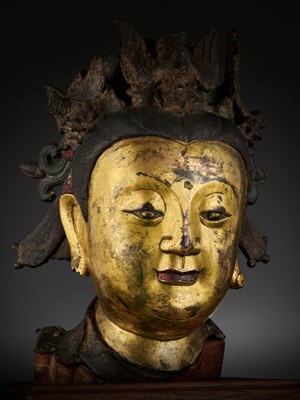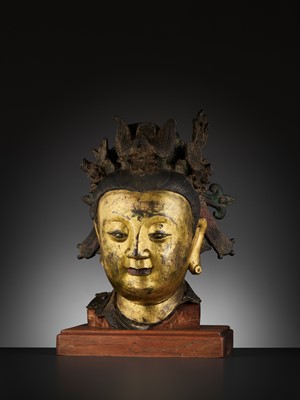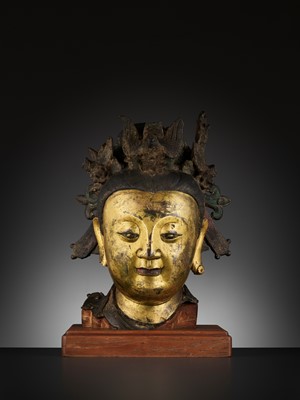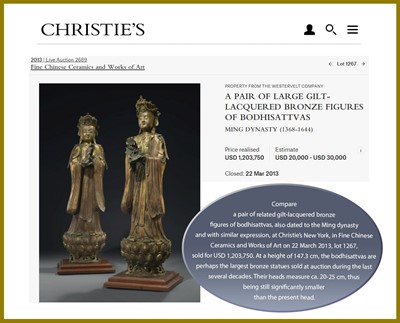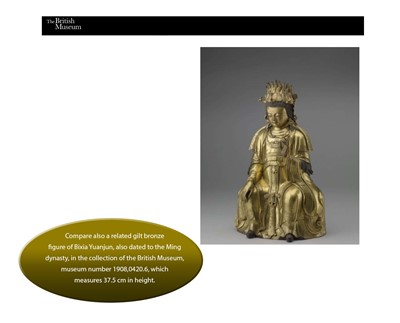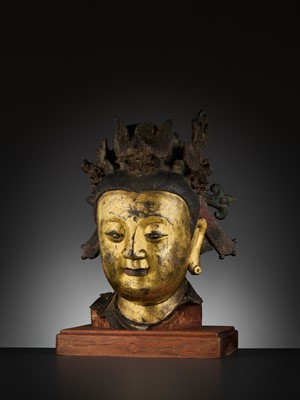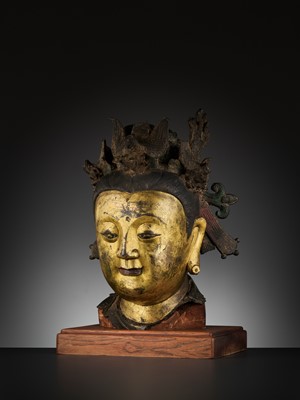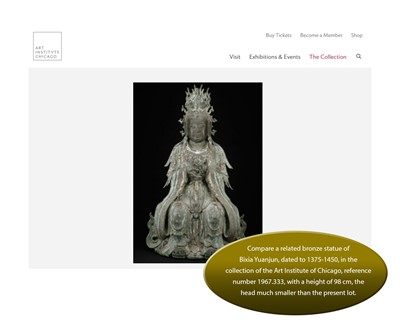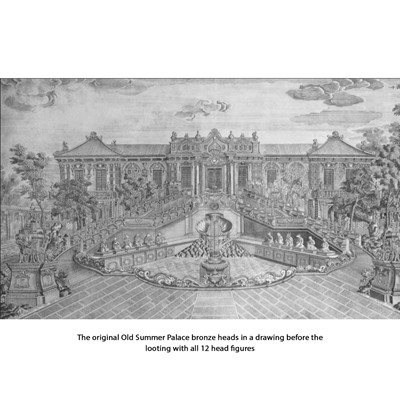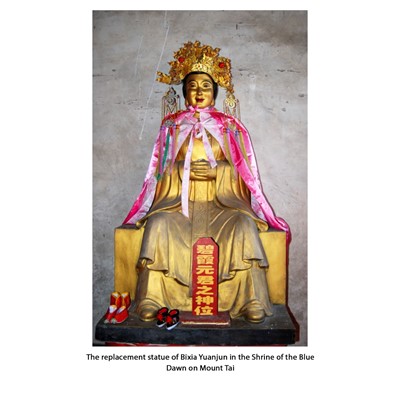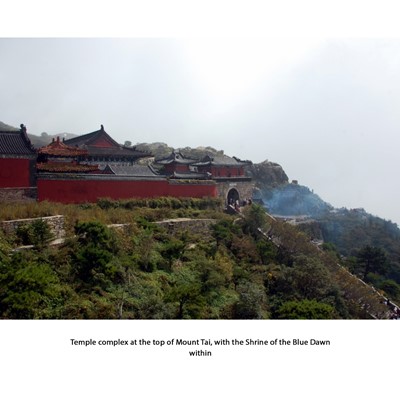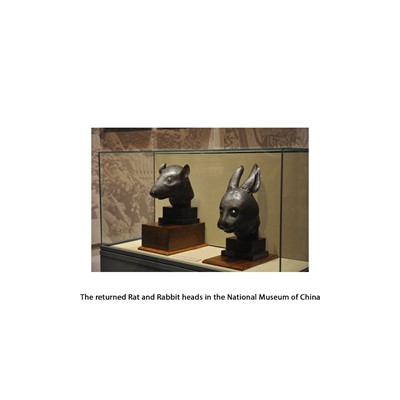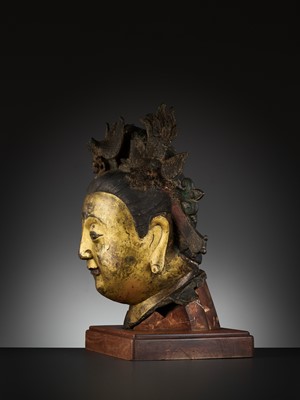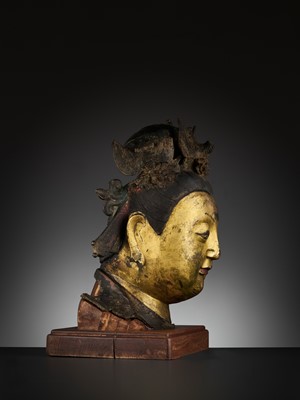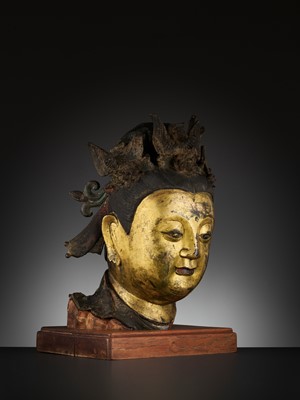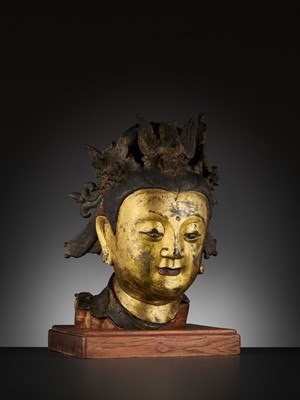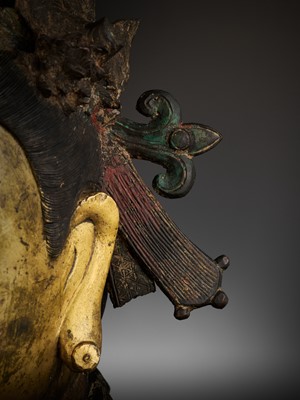16th Oct, 2021 10:00
TWO-DAY AUCTION - Fine Chinese Art / 中國藝術集珍 / Buddhism & Hinduism
384
A HIGHLY IMPORTANT AND VERY LARGE GILT-BRONZE HEAD OF BIXIA YUANJUN, THE PRIMORDIAL SOVEREIGN OF THE COLORED CLOUDS OF DAWN, MING DYNASTY
明代重要大型鎏金銅碧霞元君
Sold for €75,840
including Buyer's Premium
China, 15th-16th century. Superbly cast, the serene face with a fine expression, heavy-lidded downcast eyes below gently arched eyebrows, full lips forming a calm smile, flanked by long earlobes, the hair arranged in a chignon framed by an elaborate headdress composed of three phoenixes.
Provenance: From an old private estate in New York, USA. Lark Mason Associates, New York, USA, Fall 2013. A noted private collection, acquired from the above.
Condition: Presents very well overall and is in good condition, fully commensurate with age, absolutely original with no repairs or restoration whatsoever. Extensive wear, some weathering, several losses as seen on images, no hidden damages. Minor nicks and dents, light scratches. Remnants of ancient pigment. Some malachite-green encrustations, particularly to the headdress. Good naturally grown patina.
Weight: 28.2 kg (incl. base)
Dimensions: Height 48 cm (from the base to the highest point) and 43.5 cm (excl. base)
With an old fitted hardwood base, probably dating to the late Qing Dynasty or Republican era. (2)
Bixia Yuanjun is a goddess in Chinese folk religion and Daoism. She is the daughter of Dongyue Dadi, the main god of Mount Tai, the easternmost of the Five Sacred Mountains in Shandong Province, where the Shrine of the Blue Dawn (Bixia Ci) was built at the top of the mountain during the Ming dynasty. Her name has been rendered variously in English-language sources, such as ‘Sovereign of the Clouds of Dawn’ or ‘The Primordial Goddess of the Morning Clouds’. During the Ming and early Qing dynasties, she became one of the most popular deities in Northern China with her influence actively spread by Tai'an City, Shandong Province. Her following extended to the Lower Yangzi region as well, and she also enjoyed significant patronage from the Imperial court. As the goddess of dawn, she attends the birth of each new day from her home high in the clouds. As the goddess of childbirth, she attends the birth of children, fixing their destiny and bringing good fortune. Bixia Yuanjin is venerated in the Temple of the Purple Dawn at the summit of the holy mountain, Mount Tai, where women wishing to conceive come to ask her for help.
Mount Tai is known as the eastern mountain of the Sacred Mountains of China. It is associated with sunrise, birth, and renewal, and is often regarded the foremost of the five. Mount Tai has been a place of worship for at least 3,000 years and served as one of the most important ceremonial centers of China during large portions of this period.
The Shrine of the Blue Dawn near the top of the mountain is a grand building complex, a special combination of metal components, wood, bricks and stone structures, dedicated to Bixia Yuanjun. A large statue of the goddess is enshrined in the main temple building. It is a replacement of a significantly earlier sculpture, which was probably stolen during the Opium Wars (1839-1842 and 1856-1860), the Taiping (1850-1864) or Boxer Rebellions (1900-1901), the Chinese Civil War (1927-1949), or maybe even as early as the transition period from the Ming to the Qing dynasty.
The world of Chinese art and its history are rife with stories of looting and theft, sometimes resulting eventually in repatriation. One of the perhaps most dramatic and famous begins with the destruction of the Old Summer Palace in Beijing in 1860, during the Second Opium War. As the Anglo-French expedition force steadily approached Beijing, two British envoys, a journalist for The Times and a small escort of British and Indian troopers were sent to meet Prince Yi under a flag of truce to negotiate a Qing surrender. Meanwhile, the French and British troops reached the palace. As news emerged that the negotiation delegation had been imprisoned and tortured, resulting in 20 deaths, the British retaliated by ordering the complete destruction of the palace. The palace was so large – covering more than 3.5 square kilometers – that it took 4,000 men three full days of burning to destroy it. One of the most important artworks stolen were the twelve bronze fountainheads in the shape of zodiac animals that were part of a water clock fountain. Supposedly designed by Giuseppe Castiglione for the Qianlong Emperor, the statues would spout out water from their mouths to tell the time.
Almost exactly 150 years later, in February 2009, two of the bronze sculptures – heads of a Rat and a Rabbit – were sold for 28 million euros to Cai Mingchao, an adviser to the People’s Republic of China’s National Treasures Fund, as part of an auction of art works owned by the late French designer Yves Saint Laurent. Cai then refused to pay the sum bid, claiming that he was bidding on moral and patriotic grounds. A heavily publicized scandal ensued, with the heads becoming one of the most visible examples of attempts to repatriate Chinese art and cultural artifacts. Eventually, the Rat and Rabbit bronze heads were returned to China, donated by François Pinault in a ceremony on June 28, 2013. The bronze heads are now housed in the National Museum of China.
Expert’s note: Given the exceptional size of this head, the whole statue must have had a height ranging between ca. 240 to 280 cm standing, depending on the exact size of the base. Gilt bronze statues of this superlative dimension and from this period are extremely rare and literally never appear on the auction market. Due to its gigantic size, it is likely that the complete statue to which the present head once belonged was originally housed in a temple complex open to the public, in Shandong Province, or possibly even in the Shrine of the Blue Dawn itself. Regardless from where it was taken, at some point the head was removed from the body, which was subsequently taken apart and most likely smelted for sale.
Literature comparison: Compare a related bronze statue of Bixia Yuanjun, dated to 1375-1450, in the collection of the Art Institute of Chicago, reference number 1967.333, with a height of 98 cm, the head much smaller than the present lot. Compare also a related gilt bronze figure of Bixia Yuanjun, also dated to the Ming dynasty, in the collection of the British Museum, museum number 1908,0420.6, which measures 37.5 cm in height.
Auction result comparison: Compare a pair of related gilt-lacquered bronze figures of bodhisattvas, also dated to the Ming dynasty and with a similar expression, at Christie’s New York, in Fine Chinese Ceramics and Works of Art on 22 March 2013, lot 1267, sold for USD 1,203,750. At a height of 147.3 cm, the bodhisattvas are perhaps the largest bronze statues sold at auction during the last several decades. Their heads measure ca. 20-25 cm, thus being still significantly smaller than the present head.
明代重要大型鎏金銅碧霞元君
中國,十五至十六世紀。造型絕美,面容端莊,神情清秀,雙眸下垂,眉眼微彎,豐唇笑意盈盈,兩側長耳垂,髮髻被由三隻鳳凰組成的精美頭飾固定。
來源:紐約私人老收藏;紐約Lark Mason Associates, 2013年球季;知名私人收藏,購於上述收藏。
品相:整體呈現非常好,品相良好,完全符合其年代特徵,絕對原裝,沒有任何修補。磨損嚴重,局部風化和缺損,無隱藏損壞。輕微的劃痕和凹痕。古顏料的殘餘。 一些孔雀石綠色結殼,尤其是頭飾部分。 良好的自然生長的包漿。
重量:28.2 公斤(含底座)
尺寸:高48 釐米 (從底座至最高處),43.5 釐米 (不含底座)
老硬木底座,可能是來自晚清或民國時期。 (2)
碧霞元君是中國民間宗教和道教中的女神。傳説中,她是中國五嶽之尊東岳泰山主神東嶽大帝的女兒,明代曾在山頂建造了碧霞祠。她的名字在英文資料中的呈現方式各不相同,例如“黎明之雲的君主”或“晨雲的原始女神”。明清初年,她的影響在山東省泰安市極爲廣大,成為華北地區最受歡迎的女神之一。她的追隨者也擴展到了長江和淮河以北,同時也受到了朝廷的冊封。作為黎明女神,她在雲端的家中迎接每一天的誕生。同時,作爲主宰生兒育女的女神,據稱碧霞元君可賜善信孩子與健康,守護孩童,決定他們的命運並帶來好運。每年到泰山碧霞元君祠朝山進香的十方善信摩肩接踵絡繹不絕。
泰山素有中國五嶽之尊之稱,因爲它與日出、出生和更新有關。 泰山作為道場已有至少 3000 年的歷史,在這一時期的大部分時間裡,它是中國最重要的祭祀中心之一。
碧霞元君祠位於泰山極頂之南,是道教著名女神碧霞元君的祖庭,為泰山最大的高山古建築群,由金屬構件、木、磚和石結構的特殊組合而成。 殿內正中神龕內供奉的是碧霞元君貼金銅坐像,它取代了一座可能在鴉片戰爭至中國內戰(1927 -1949年)期間被盜的一座碧霞元君像 ,甚至可能早在明清過渡時期。
中國藝術史裏充斥著搶劫和盜竊。最悲劇性和最著名的事件之一,應該是1860 年第二次鴉片戰爭期間北京圓明園的毀壞。隨著英法遠征軍穩步逼近北京,兩名英國特使、一名《泰晤士報》記者和一小隊英印士兵被派去會見怡親王,就清朝投降進行談判。聯軍發現清軍將英法使節團軍虐待至死,遂決定報復。英國下令徹底摧毀圓明園進行報復。圓明園如此之大,佔地超過 3.5 平方公里,以至於 4,000 人花了整整三天的時間才將它燒毀。被盜的最重要的藝術品之一是十二生肖動物形狀的青銅噴泉,十二生肖銅像是由義大利傳教士、著名宮廷畫師郎世寧設計,安裝在圓明園海晏堂的水池前,每天不同時刻,銅像口依次噴水,所以十二生肖銅像不僅是用來觀賞,還是一個記錄時間的鐘,堪稱世界一絕。
幾乎整整 150 年後的 2009 年 2 月,中華搶救流失海外文物專項基金國寶工程收藏顧問的蔡銘超以 2800 萬歐元的價格(不含傭金)拍下鼠首和兔首。蔡隨後拒絕支付總價,聲稱他是出於道德和愛國的考慮。最終,2013年6月28日,弗朗索瓦·皮諾(François Pinault)在儀式上捐贈了鼠兔青銅頭像。青銅頭像現收藏於中國國家博物館。
專家注釋:考慮到這個頭像不同尋常的尺寸,整個雕像的高度應該約 240 至 280 釐米之間,具體取決於底座的確切尺寸。 那個時期這麽高的鎏金銅像極為罕見,幾乎從未出現在拍賣市場上。 由於其巨大的尺寸,現在的頭部曾經所屬的完整雕像很可能來自山東的一個寺廟或也很可能在碧霞元君祠。不管它來自何處,它的身體部位很可能已經被拆開,也很可能被冶煉出售。
文獻比較:一件被收藏在芝加哥Art Institute的 1375-1450年間碧霞元君銅像 ,編號 1967.333, 高98 釐米,頭小於此拍品。另一件明代碧霞元君銅像收藏在大不列顛博物館,編號 1908,0420.6,高37.5 釐米。
拍賣結果比較:一對明代鎏金漆菩薩銅像見紐約佳士得Fine Chinese Ceramics and Works of Art 2013年3月 22日 lot 1267, 售價USD 1,203,750。 高147.3 厘米的菩薩銅像應該是近幾十年來最大的銅像了。他們的頭像約 20-25 釐米,比現在這個頭像要小很多。
China, 15th-16th century. Superbly cast, the serene face with a fine expression, heavy-lidded downcast eyes below gently arched eyebrows, full lips forming a calm smile, flanked by long earlobes, the hair arranged in a chignon framed by an elaborate headdress composed of three phoenixes.
Provenance: From an old private estate in New York, USA. Lark Mason Associates, New York, USA, Fall 2013. A noted private collection, acquired from the above.
Condition: Presents very well overall and is in good condition, fully commensurate with age, absolutely original with no repairs or restoration whatsoever. Extensive wear, some weathering, several losses as seen on images, no hidden damages. Minor nicks and dents, light scratches. Remnants of ancient pigment. Some malachite-green encrustations, particularly to the headdress. Good naturally grown patina.
Weight: 28.2 kg (incl. base)
Dimensions: Height 48 cm (from the base to the highest point) and 43.5 cm (excl. base)
With an old fitted hardwood base, probably dating to the late Qing Dynasty or Republican era. (2)
Bixia Yuanjun is a goddess in Chinese folk religion and Daoism. She is the daughter of Dongyue Dadi, the main god of Mount Tai, the easternmost of the Five Sacred Mountains in Shandong Province, where the Shrine of the Blue Dawn (Bixia Ci) was built at the top of the mountain during the Ming dynasty. Her name has been rendered variously in English-language sources, such as ‘Sovereign of the Clouds of Dawn’ or ‘The Primordial Goddess of the Morning Clouds’. During the Ming and early Qing dynasties, she became one of the most popular deities in Northern China with her influence actively spread by Tai'an City, Shandong Province. Her following extended to the Lower Yangzi region as well, and she also enjoyed significant patronage from the Imperial court. As the goddess of dawn, she attends the birth of each new day from her home high in the clouds. As the goddess of childbirth, she attends the birth of children, fixing their destiny and bringing good fortune. Bixia Yuanjin is venerated in the Temple of the Purple Dawn at the summit of the holy mountain, Mount Tai, where women wishing to conceive come to ask her for help.
Mount Tai is known as the eastern mountain of the Sacred Mountains of China. It is associated with sunrise, birth, and renewal, and is often regarded the foremost of the five. Mount Tai has been a place of worship for at least 3,000 years and served as one of the most important ceremonial centers of China during large portions of this period.
The Shrine of the Blue Dawn near the top of the mountain is a grand building complex, a special combination of metal components, wood, bricks and stone structures, dedicated to Bixia Yuanjun. A large statue of the goddess is enshrined in the main temple building. It is a replacement of a significantly earlier sculpture, which was probably stolen during the Opium Wars (1839-1842 and 1856-1860), the Taiping (1850-1864) or Boxer Rebellions (1900-1901), the Chinese Civil War (1927-1949), or maybe even as early as the transition period from the Ming to the Qing dynasty.
The world of Chinese art and its history are rife with stories of looting and theft, sometimes resulting eventually in repatriation. One of the perhaps most dramatic and famous begins with the destruction of the Old Summer Palace in Beijing in 1860, during the Second Opium War. As the Anglo-French expedition force steadily approached Beijing, two British envoys, a journalist for The Times and a small escort of British and Indian troopers were sent to meet Prince Yi under a flag of truce to negotiate a Qing surrender. Meanwhile, the French and British troops reached the palace. As news emerged that the negotiation delegation had been imprisoned and tortured, resulting in 20 deaths, the British retaliated by ordering the complete destruction of the palace. The palace was so large – covering more than 3.5 square kilometers – that it took 4,000 men three full days of burning to destroy it. One of the most important artworks stolen were the twelve bronze fountainheads in the shape of zodiac animals that were part of a water clock fountain. Supposedly designed by Giuseppe Castiglione for the Qianlong Emperor, the statues would spout out water from their mouths to tell the time.
Almost exactly 150 years later, in February 2009, two of the bronze sculptures – heads of a Rat and a Rabbit – were sold for 28 million euros to Cai Mingchao, an adviser to the People’s Republic of China’s National Treasures Fund, as part of an auction of art works owned by the late French designer Yves Saint Laurent. Cai then refused to pay the sum bid, claiming that he was bidding on moral and patriotic grounds. A heavily publicized scandal ensued, with the heads becoming one of the most visible examples of attempts to repatriate Chinese art and cultural artifacts. Eventually, the Rat and Rabbit bronze heads were returned to China, donated by François Pinault in a ceremony on June 28, 2013. The bronze heads are now housed in the National Museum of China.
Expert’s note: Given the exceptional size of this head, the whole statue must have had a height ranging between ca. 240 to 280 cm standing, depending on the exact size of the base. Gilt bronze statues of this superlative dimension and from this period are extremely rare and literally never appear on the auction market. Due to its gigantic size, it is likely that the complete statue to which the present head once belonged was originally housed in a temple complex open to the public, in Shandong Province, or possibly even in the Shrine of the Blue Dawn itself. Regardless from where it was taken, at some point the head was removed from the body, which was subsequently taken apart and most likely smelted for sale.
Literature comparison: Compare a related bronze statue of Bixia Yuanjun, dated to 1375-1450, in the collection of the Art Institute of Chicago, reference number 1967.333, with a height of 98 cm, the head much smaller than the present lot. Compare also a related gilt bronze figure of Bixia Yuanjun, also dated to the Ming dynasty, in the collection of the British Museum, museum number 1908,0420.6, which measures 37.5 cm in height.
Auction result comparison: Compare a pair of related gilt-lacquered bronze figures of bodhisattvas, also dated to the Ming dynasty and with a similar expression, at Christie’s New York, in Fine Chinese Ceramics and Works of Art on 22 March 2013, lot 1267, sold for USD 1,203,750. At a height of 147.3 cm, the bodhisattvas are perhaps the largest bronze statues sold at auction during the last several decades. Their heads measure ca. 20-25 cm, thus being still significantly smaller than the present head.
明代重要大型鎏金銅碧霞元君
中國,十五至十六世紀。造型絕美,面容端莊,神情清秀,雙眸下垂,眉眼微彎,豐唇笑意盈盈,兩側長耳垂,髮髻被由三隻鳳凰組成的精美頭飾固定。
來源:紐約私人老收藏;紐約Lark Mason Associates, 2013年球季;知名私人收藏,購於上述收藏。
品相:整體呈現非常好,品相良好,完全符合其年代特徵,絕對原裝,沒有任何修補。磨損嚴重,局部風化和缺損,無隱藏損壞。輕微的劃痕和凹痕。古顏料的殘餘。 一些孔雀石綠色結殼,尤其是頭飾部分。 良好的自然生長的包漿。
重量:28.2 公斤(含底座)
尺寸:高48 釐米 (從底座至最高處),43.5 釐米 (不含底座)
老硬木底座,可能是來自晚清或民國時期。 (2)
碧霞元君是中國民間宗教和道教中的女神。傳説中,她是中國五嶽之尊東岳泰山主神東嶽大帝的女兒,明代曾在山頂建造了碧霞祠。她的名字在英文資料中的呈現方式各不相同,例如“黎明之雲的君主”或“晨雲的原始女神”。明清初年,她的影響在山東省泰安市極爲廣大,成為華北地區最受歡迎的女神之一。她的追隨者也擴展到了長江和淮河以北,同時也受到了朝廷的冊封。作為黎明女神,她在雲端的家中迎接每一天的誕生。同時,作爲主宰生兒育女的女神,據稱碧霞元君可賜善信孩子與健康,守護孩童,決定他們的命運並帶來好運。每年到泰山碧霞元君祠朝山進香的十方善信摩肩接踵絡繹不絕。
泰山素有中國五嶽之尊之稱,因爲它與日出、出生和更新有關。 泰山作為道場已有至少 3000 年的歷史,在這一時期的大部分時間裡,它是中國最重要的祭祀中心之一。
碧霞元君祠位於泰山極頂之南,是道教著名女神碧霞元君的祖庭,為泰山最大的高山古建築群,由金屬構件、木、磚和石結構的特殊組合而成。 殿內正中神龕內供奉的是碧霞元君貼金銅坐像,它取代了一座可能在鴉片戰爭至中國內戰(1927 -1949年)期間被盜的一座碧霞元君像 ,甚至可能早在明清過渡時期。
中國藝術史裏充斥著搶劫和盜竊。最悲劇性和最著名的事件之一,應該是1860 年第二次鴉片戰爭期間北京圓明園的毀壞。隨著英法遠征軍穩步逼近北京,兩名英國特使、一名《泰晤士報》記者和一小隊英印士兵被派去會見怡親王,就清朝投降進行談判。聯軍發現清軍將英法使節團軍虐待至死,遂決定報復。英國下令徹底摧毀圓明園進行報復。圓明園如此之大,佔地超過 3.5 平方公里,以至於 4,000 人花了整整三天的時間才將它燒毀。被盜的最重要的藝術品之一是十二生肖動物形狀的青銅噴泉,十二生肖銅像是由義大利傳教士、著名宮廷畫師郎世寧設計,安裝在圓明園海晏堂的水池前,每天不同時刻,銅像口依次噴水,所以十二生肖銅像不僅是用來觀賞,還是一個記錄時間的鐘,堪稱世界一絕。
幾乎整整 150 年後的 2009 年 2 月,中華搶救流失海外文物專項基金國寶工程收藏顧問的蔡銘超以 2800 萬歐元的價格(不含傭金)拍下鼠首和兔首。蔡隨後拒絕支付總價,聲稱他是出於道德和愛國的考慮。最終,2013年6月28日,弗朗索瓦·皮諾(François Pinault)在儀式上捐贈了鼠兔青銅頭像。青銅頭像現收藏於中國國家博物館。
專家注釋:考慮到這個頭像不同尋常的尺寸,整個雕像的高度應該約 240 至 280 釐米之間,具體取決於底座的確切尺寸。 那個時期這麽高的鎏金銅像極為罕見,幾乎從未出現在拍賣市場上。 由於其巨大的尺寸,現在的頭部曾經所屬的完整雕像很可能來自山東的一個寺廟或也很可能在碧霞元君祠。不管它來自何處,它的身體部位很可能已經被拆開,也很可能被冶煉出售。
文獻比較:一件被收藏在芝加哥Art Institute的 1375-1450年間碧霞元君銅像 ,編號 1967.333, 高98 釐米,頭小於此拍品。另一件明代碧霞元君銅像收藏在大不列顛博物館,編號 1908,0420.6,高37.5 釐米。
拍賣結果比較:一對明代鎏金漆菩薩銅像見紐約佳士得Fine Chinese Ceramics and Works of Art 2013年3月 22日 lot 1267, 售價USD 1,203,750。 高147.3 厘米的菩薩銅像應該是近幾十年來最大的銅像了。他們的頭像約 20-25 釐米,比現在這個頭像要小很多。
Zacke Live Online Bidding
Our online bidding platform makes it easier than ever to bid in our auctions! When you bid through our website, you can take advantage of our premium buyer's terms without incurring any additional online bidding surcharges.
To bid live online, you'll need to create an online account. Once your account is created and your identity is verified, you can register to bid in an auction up to 12 hours before the auction begins.
Intended Spend and Bid Limits
When you register to bid in an online auction, you will need to share your intended maximum spending budget for the auction. We will then review your intended spend and set a bid limit for you. Once you have pre-registered for a live online auction, you can see your intended spend and bid limit by going to 'Account Settings' and clicking on 'Live Bidding Registrations'.
Your bid limit will be the maximum amount you can bid during the auction. Your bid limit is for the hammer price and is not affected by the buyer’s premium and VAT. For example, if you have a bid limit of €1,000 and place two winning bids for €300 and €200, then you will only be able to bid €500 for the rest of the auction. If you try to place a bid that is higher than €500, you will not be able to do so.
Online Absentee and Telephone Bids
You can now leave absentee and telephone bids on our website!
Absentee Bidding
Once you've created an account and your identity is verified, you can leave your absentee bid directly on the lot page. We will contact you when your bids have been confirmed.
Telephone Bidding
Once you've created an account and your identity is verified, you can leave telephone bids online. We will contact you when your bids have been confirmed.
Classic Absentee and Telephone Bidding Form
You can still submit absentee and telephone bids by email or fax if you prefer. Simply fill out the Absentee Bidding/Telephone bidding form and return it to us by email at office@zacke.at or by fax at +43 (1) 532 04 52 20. You can download the PDF from our Upcoming Auctions page.
How-To Guides
How to Create Your Personal Zacke Account
How to Register to Bid on Zacke Live
How to Leave Absentee Bids Online
How to Leave Telephone Bids Online
中文版本的操作指南
创建新账号
注册Zacke Live在线直播竞拍(免平台费)
缺席投标和电话投标
Third-Party Bidding
We partner with best-in-class third-party partners to make it easy for you to bid online in the channel of your choice. Please note that if you bid with one of our third-party online partners, then there will be a live bidding surcharge on top of your final purchase price. You can find all of our fees here. Here's a full list of our third-party partners:
- 51 Bid Live
- EpaiLive
- ArtFoxLive
- Invaluable
- LiveAuctioneers
- the-saleroom
- lot-tissimo
- Drouot
Please note that we place different auctions on different platforms. For example, in general, we only place Chinese art auctions on 51 Bid Live.
Bidding in Person
You must register to bid in person and will be assigned a paddle at the auction. Please contact us at office@zacke.at or +43 (1) 532 04 52 for the latest local health and safety guidelines.
